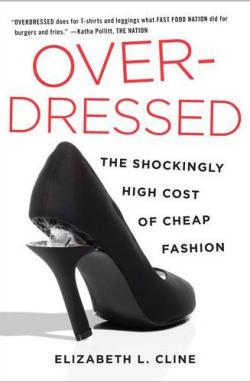The Organizing Diva is gently reminding all her readers to be mindful of your clothing purchases. Buying more, new and cheap isn’t always a good idea for you, your closet or the planet. Please read the article, by Slate.com The Afterlife of Cheap Clothes.
Following is an excerpt from Overdressed: The Shockingly High Cost of Cheap Fashion, out now from Viking.
It was early morning at the Quincy Street Salvation Army, an easy-to-miss location tucked away on a  Brooklyn side street. The only donations that had come in so far were books, an entire truck full from one single apartment. Charitable clothing donations usually roll in with fits and starts, with the changing of the seasons and at the end of the year, when people are looking for tax write-offs. It was on a weekday morning in the middle of the fall, the off-hours for clothing donations. But I didn’t have to witness someone pulling up their car and shoveling bags full of clothes from the trunk. I’d been that person innumerable times, lugging overloaded trash bags, pierced by the heels of cheap pumps, sleeves and pant legs hanging out, to a local charity. I had never known what happens after I drive away and leave my old clothing orphaned on the Salvation Army’s doorstep.
Brooklyn side street. The only donations that had come in so far were books, an entire truck full from one single apartment. Charitable clothing donations usually roll in with fits and starts, with the changing of the seasons and at the end of the year, when people are looking for tax write-offs. It was on a weekday morning in the middle of the fall, the off-hours for clothing donations. But I didn’t have to witness someone pulling up their car and shoveling bags full of clothes from the trunk. I’d been that person innumerable times, lugging overloaded trash bags, pierced by the heels of cheap pumps, sleeves and pant legs hanging out, to a local charity. I had never known what happens after I drive away and leave my old clothing orphaned on the Salvation Army’s doorstep.
Michael Noneza, otherwise known as “Maui,” one of the donation center’s assistant supervisors, bounced into the warehouse. “You ready?” the cheery Pacific Islander asked, and ushered me over to a massive freight elevator and pressed the button for the third floor. The elevator jolted upward and the doors opened on a scene that looked a bit like a threadbare Santa’s workshop. Dozens of Hispanic women were standing behind a row of wooden slides, pulling clothes out of elephantine gray bins and separating them into broad categories like jackets, pants, and childrenswear. “We keep only the best,” Maui told me. “Then it’s ticketed and priced.” The pricers, perched on what looked like adult high chairs, quickly and methodically moved through racks of 80 garments each, making snap judgments based on condition and brand.
The Quincy Street Salvation Army may be on a quiet out-of-the-way street, but it is the main distribution center serving eight Salvation Army locations in Brooklyn and Queens. It processes an average of five tons of outcast clothing every single day of the year, and much more during the holiday season when donations spike. From that astonishing mass, the sorters choose exactly 11,200 garments a day to be divided up equally between the eight thrift stores they serve. I asked Maui if they’ve ever hit a dry spell, where the donations dipped too low to fully restock each stores with their share of the 11,200 items. He laughed, “We never run out of clothes. There are always enough clothes.”
What American doesn’t have something hanging in his or her closet worn only once or twice, a pair of pants waiting for a diet, or even a brand-new dress or jacket with the tags still on? Common sense and everyday experience tell us that we have so many clothes that a majority go underused and neglected. According to a 2010 national survey in ShopSmart magazine, one in four American women own seven pairs of jeans, but we only wear four of them regularly. Not surprisingly, charities regularly see brand-new clothes come in with tags still affixed. “We see people throwing away new stuff every day,” Maui says.
There is an enormous disconnect between increasing clothing consumption and the resultant waste, partially because unworn clothes aren’t immediately thrown out like other disposable products. Instead, they accumulate in our closets or wherever we can find space for them. Master closets now average about 6 feet by 8 feet, a size more typical of an extra bedroom 40 years ago.
To Continue reading this article

Follow Us!